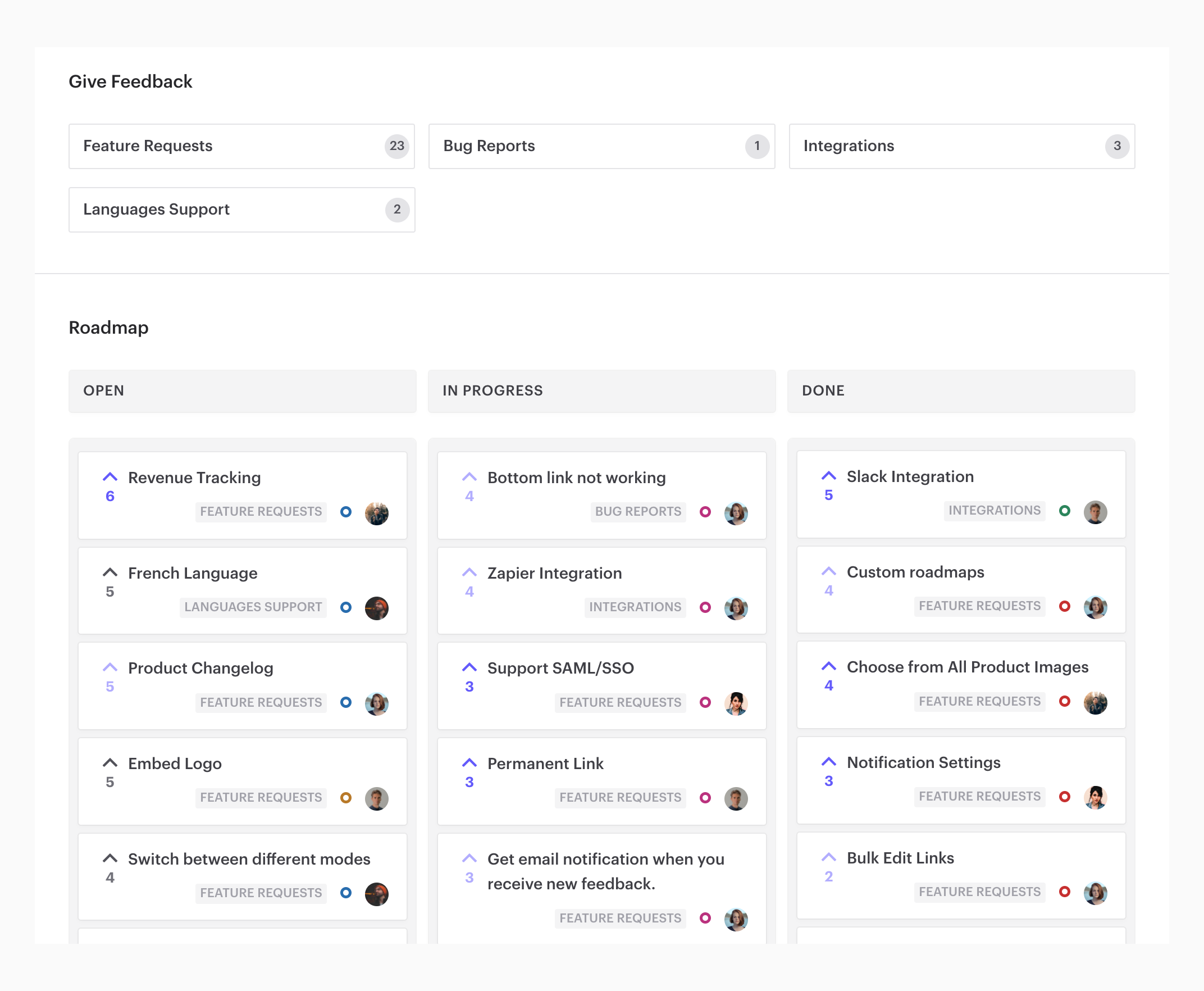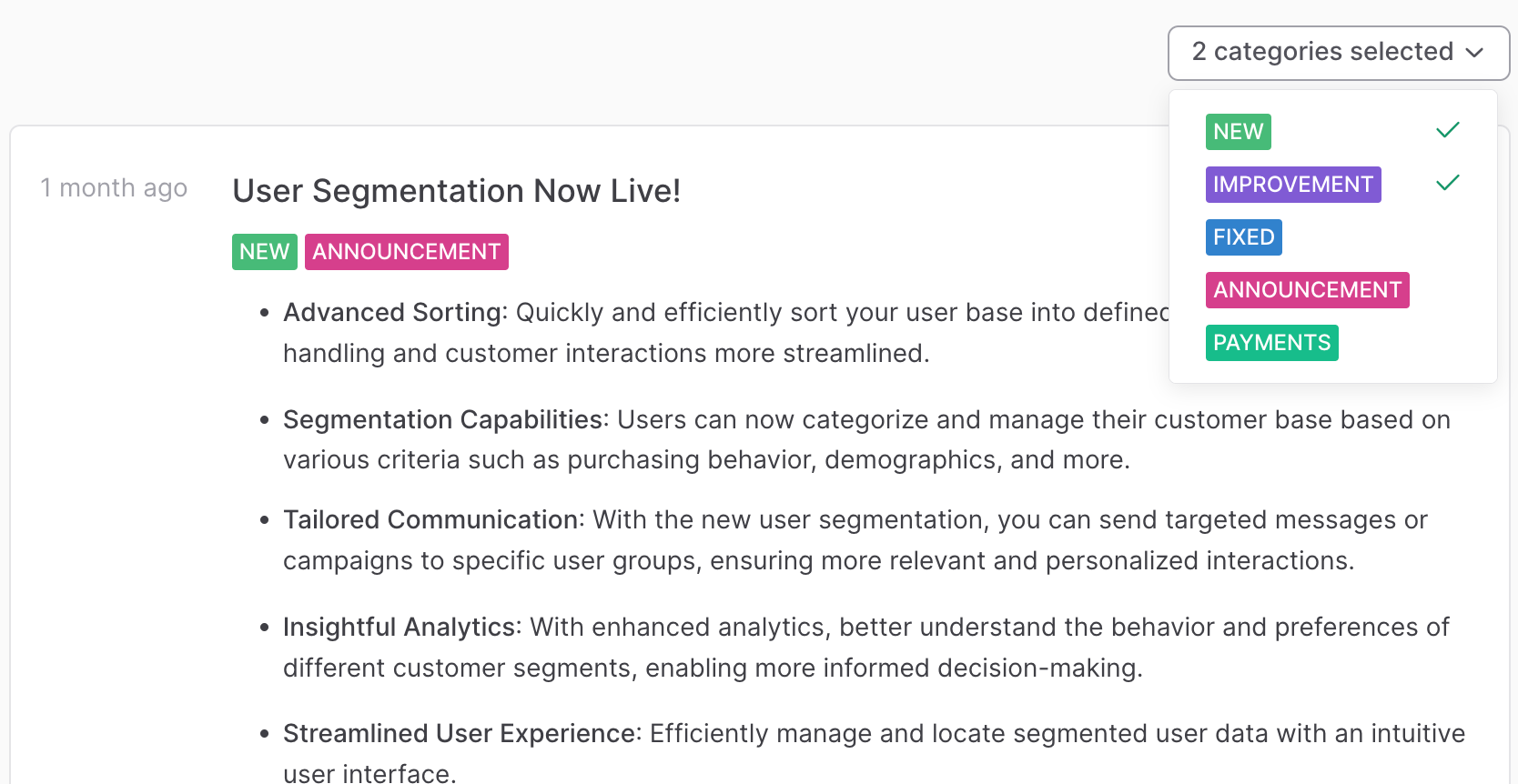
How to Drive Product Adoption with Customer Feedback
Most SaaS companies launch a great product and focus their energy on encouraging users to sign up for a free trial. However, just 25% of them get converted into paying customers.
Let's face it, with multiple alternatives available in the market, convincing more people to sign up for the product can be challenging. So in this article, we’ve explained the concept of product adoption and five ways to increase the metric.
What is product adoption?
Product adoption is how users learn about your product, recognize its benefits, and start using it. It's that stage when they finally invest in it and stop seeking alternative solutions to meet their goals.
Product adoption is essential for any SaaS business because SaaS business models are subscription-based. And to maintain the monthly or annual recurring revenue, you need to create strategies to increase product adoption and customer retention.
Why is product adoption important for your business?
Product adoption helps you move from the stage where the user likes the product to where a user is ready to subscribe and pay money. Because it takes a higher commitment level to reach this stage, here are a few reasons you need to create product adoption strategies.
- Product adoption lowers your churn rate and improves your customer retention rate. It’s interesting to know that you can increase your profits by a whopping 25 to 95% by improving your retention rate by 5%.
- For subscription-based business models like SaaS products, it's vital to reduce new customer acquisition costs and focus on having loyal customers because it is approximately 2X cheaper to upsell to an existing customer than to acquire a new one.
Product adoption can be your best friend for your SaaS business because it can enhance the conversion rate of free users to paying customers. But you can't improve what you can't measure, so how can you understand how good your product adoption rate is? This brings us to our next question!
What are product adoption metrics?
Product adoption metrics are an indicator to measure how your users realize the value of your product.
It’s measured based on four factors:
- Stickiness: This is the percentage of users who log in to your product a minimum number of times over some time.
- Feature Adoption: This counts the number of users who engage with a given product feature more often at a given time.
- Growth: You can calculate this by dividing the number of newly created accounts by the number of deleted accounts.
- Minimum Active Users (MAU): This gauges the typical monthly usage of unique users of your product.
How to measure product adoption?
Tracking product adoption metrics is an important part of any product adoption strategy. It helps identify the metrics contributing to your business to save time and not have to track every possible data to see results.
Best product adoption metrics to track for your SaaS business
Here are four crucial product adoption metrics you should track religiously:
Adoption rate
The adoption rate tells you who is your active users. Here’s how to calculate it:
Product Adoption Rate = (Active Users / Total Number of Visitors) x 100
Calculating your adoption rate leads to additional analysis, like comparing rates for various user cohorts or features of your product.
Conversion rate
It is the percentage of all visitors who upgrade their plan from free to paid service. For example, the percentage of users who signed up for a paid version of your product after their free trial.
Here’s how you can calculate it:
Conversion Rate = (Conversions / Total Number of Visitors) x 100
Time to Value
In SaaS, time to value (TTV) determines how long users use a product and their activation event after signing up for it. The shorter the time to value, the better it is because you can expect your customers to benefit from your product immediately.
Usage frequency
It is similar to active users but as a percentage of your total customer base. The more users your software receives, the better. You can determine how often your product or features are used throughout.
Here’s a formula to calculate it:
Usage Frequency = (Number of users accessing your product in a given period / Total Number of Visitors) x 100
Product adoption curve: Five customer segments to look out for
The product adoption curve is a standard model illustrating how and when different types of users adopt your product.
The 5 Customer Segments are:
Innovators
This segment makes up 2.5% of the market and is the one that’s excited about new products. They enjoy experimenting with new tools and are an ideal source of feedback.
However, retaining this customer group is challenging because they can change their mind whenever they see a new product.
Early adopters
This segment, which consists of 13.5%, expects good product performance and looks for support when it doesn't function as expected.
Unlike innovators, they won’t invest in a product filled with bugs. So as soon as you have an early adopter’s attention, you can’t slack off because they expect excellent customer service.
Early Majority
This segment which makes up 34% of the total, doesn’t include risk-takers and prefers tried-and-true products. They like building close relationships with innovators and early adopters to win the early majority's trust. Once they sign up for your product, their risk aversion will make them your devoted customers.
Late majority
The Late Majority (34%) is quite similar to the early majority, except they are less tolerant of errors, more cautious, and less willing to take chances.
Laggards
A small percentage of people (16%) don't want to change until necessary. They are more comfortable staying where they are rather than taking a chance on something new—the problem of customer inertia.
What are the five stages of product adoption?
The product adoption process goes through five stages: awareness, interest, evaluation, trial, and finally, adoption (or rejection). Here your customers proceed from being aware and informed to liking to deciding and purchasing.
1. Awareness
This is the introduction stage, where your users become aware of your product in the market. Here you need to create marketing strategies to educate your users on how well your product can solve their problems and how it's better than your competitors.
2. Interest
This is the information-gathering stage where your potential customer wants more information about your product. Along with specifics like features, price, and customer support, the information they need can vary according to their use case.
3. Evaluation
This is a consideration stage where your customer considers the benefits and drawbacks of your product and determines whether it is worth trying. During this phase, highlight your product's best features and advantages over alternatives.
4. Trial
This is the sampling stage, where your prospects sign up for a free trial or product demo to experience your product by themselves. This phase is also known as product-led growth (PLG). Here your primary focus should be on delivering a great product rather than on marketing or sales
5. Adoption/ Rejection
This is the last stage of the product adoption process. Here your users take a final call on whether your product is right for them. For SaaS products offering free trials or demos, product adoption is best indicated by users' decisions to begin paying.
Five effective ways to improve product adoption
Most people stop using a product because they find it difficult to use. People prefer simple products that can solve complex problems. As a SaaS business, here are five ways to convince prospective customers to use your product.
1. Create a frictionless user onboarding experience
Onboarding is an integral part of product adoption. 86% of people say they’d be more likely to stay loyal to a business that invests in onboarding content that educates them after buying.
Most SaaS companies work on the freemium model, so getting potential customers to try a product is the first step. Next, you must explain your product’s features and educate without overwhelming it.
Check out how Notion onboards its users with an interactive, task-based product tour. Notion has designed a guided tour as a to-do list on the "Getting Started" page. This onboarding approach encourages its users to learn the software's core functions.
2. Continuously make improvements to your product
There is a reason why few products fail in the market while some companies succeed with their product ideas.
The answer is product innovation. It means you need to improve your current product based on customer feedback. Such feedback helps you to get a clear picture of what your customer wants and how to address any issues to create a strong product portfolio.
Here are three ways to improve your product:
Add new features and announce product updates: Check out how Get Lasso does this. Announcing any new feature and sharing the public product roadmap is a must if you want your users to know about the latest product updates or releases (or releases shortly).
Reward your users for increasing usage frequency: Rewarding your users with account credit, gift cards, and other incentives can encourage them to utilize a feature of your tool more frequently. For example, dietbet, an online weight loss game app, rewards you for reaching your weight loss goal.
Make improvements to boost the new adoption rate: Based on the feedback you receive from your existing customers, improve your SaaS tool to get new customers, retain active users, and recapture lost customers. Check out how Timetastic does this:
To enhance existing features, you need customer feedback strategies to drive growth. Wherein you need to collect feedback, analyze it, use in-app announcements to promote feature updates, do A/B tests, and see what's working better that aligns with your goals.
This feedback loop should be a regular part of your business to ensure customer satisfaction.
3. Engage with In-app Messages and Behavioral Emails
When using your product, there are times when users need a little help or push, but tutorials or onboarding checklists would be too much for them.
In that case, in-app messages are the perfect elements for this job. With its help, you can guide your users to the most used, attractive features of your app or help them to give that extra push to complete the task.

4. Create a centralized place for product feedback
Collecting product feedback is an essential part of the customer experience. And more important is tracking it. But how do you track all your feedback on emails, spreadsheets, slack channels, intercom inboxes, and survey responses?
Imagine how convenient it would be to direct all feedback to a centralized place. This is possible with Rapidr.
With Rapidr, you can also group similar feedback, announce your product releases to stakeholders, align everyone with the product roadmap and avoid duplicates for better team discussion.

5. Announce New Features and Product Updates
Use a customer feedback tool like Rapidr, which provides a product changelog to announce product updates and increase feature awareness, affecting product adoption.

6. Improve user experience with approachable customer support
When customers don't understand how to use your product (even with guidance), they'll leave your product for the alternatives. To reduce the churn rate, and retain your customers, make your support team accessible.
Check out this excerpt from Capterra about Timetastic, where a user appreciates their customer support team:
Such feedback increases customer loyalty over time and gauges overall success.
Here are three ways to increase the accessibility of your support system:
- Embed Explainer videos: Embed videos and help documents for readymade answers. In these help docs, you’ll find documentation on a specific product or account-related functionality. See how Jasper does this:
Video tutorials also increase the conversion rate, and adding one to your SaaS product can help overall product adoption. Active campaign nails it with a video tutorial on its website:
- Offer In-App Chat: Live chat is a great way to connect with your new or existing customers and give them the confidence they need to use your product. Such chats provide instant answers and increase sales and higher average order value. Here’s how Rapidr does this:

- Use Chatbots For a Large User BaseYour support team can't be available 24 hours a day, so you can use chatbots to answer questions and assist your users with simple tasks. Check out how Hiver bee (a chatbot) engages with its users by answering faqs.
Drive Product Adoption with Customer Feedback
Customer feedback can help you to build better products and drive product adoption. Customer-facing teams often have the best understanding of what prevents customers from engaging.
While many customer feedback management tools help you capture, organize, and prioritize feedback, consider the one that enables you to uncover the insights from the feedback and shape your product strategy.
1. Centralized and organized by category: The first step in solving this is to organize feedback in a central location. You’ll likely receive feedback from various channels and integrations like emails, Slack channels, support inboxes, forms, and in-app widgets.
2. Easily accessible to everyone: Centralizing all feedback data in one place, which can be easily accessed, will ensure that critical feedback doesn’t get lost and will allow you to understand what to prioritize.
3. Shared across internal teams: A central hub lets customer-facing teams access and submit feedback easily. A dedicated system will also help plan regular meetups with teams to discuss customer feedback and determine how to use it to define product strategy.
4. Prioritize and analyze feedback: Prioritize features and rank feature requests and tasks based on impact to make feedback-driven decisions. Remember, it's not just about collecting feedback. The real power lies in analyzing this qualitative data and implementing actionable changes that genuinely reflect your customers' desires and pain points. This ongoing listening, learning, and improving cycle sets successful companies apart.
With Rapidr, you won’t have to worry about missing out on customer feedback. It helps SaaS companies set up a dedicated place to track different types of customer feedback, understand what customers need, and prioritize what to build next. Sign up to drive product adoption with customer feedback.

